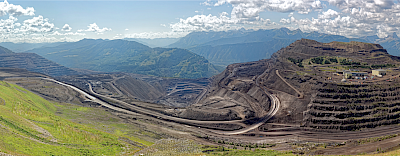Elkview Mine
Commodities: Metallurgical (coking) coal
Location: 3 km east of Sparwood, BC.
Geology and Type of Deposit: Located in the Foreland belt of the Canadian Cordillera, the Elkview coal deposit is part of the Late Jurassic and Cretaceous Kootenay Group, a sedimentary rock unit consisting of sandstone, siltstone, mudstone, shale and coal. These rocks have been complexly folded and faulted during mountain building. The coal layers were pinched and squeezed, forming large pods and creating seams that are 1 – 200 m thick. This deformation has stacked the rocks and coal beds so that the coal makes up a greater thickness than if the rocks were simply flat-lying. There are 14 mineable coal seams at Elkview, which vary in average thickness from 2 - 15 m.
The Operation: Coal mining began in the late 1800s in underground workings, and continued until the 1980s. Surface mining at the current Elkview location began in 1969. Elkview Mine is one of five coal mines in southeastern BC that are owned and operated by Teck Coal Ltd. Elkview has 270 million tonnes of coal reserves. Exploration is carried out each year to firm up the estimates of proven reserves. Current production and preparation plant capacity is 7.4 million tonnes/year. Based on current reserves and production rates, operations at Elkview are predicted to continue for another 35 years.
Mining Method: Conventional open pit coal mining. Blasting is done every 2-3 days. Blasted material is loaded by electric shovels into haul trucks. Coal is hauled by truck to a hopper facility where it falls onto a conveyor which moves it 3.5-km overland to a crusher.
Processing: The crushed coal is conveyed 1.5 km through a tunnel to raw coal silos which hold the coal and supply the coal wash plant. Here the coal passes through screen and is sorted by size. The coarsest material (> 6.4 cm by 1.3 cm) passes into a cyclone that uses a heavy magnetite slurry to separate the coal from the waste rock. While the finest material (< 0.5 mm) is directed through a water-only cyclone, then a dilute cyclone, and finally to froth flotation cells to separate the fine coal from waste rock sand. Cleaned coal from all the circuits is then sent to a thermal dryer to reduce the moisture, and from there is conveyed to large silos where it is stored until it is loaded onto a train and shipped to markets. Waste rock material, that is separated from coal in the preparation plant, called refuse or rejects, is hauled by truck to a waste rock dump, or deposited in a tailings pond.
Markets: Elkview Mine produces four different cleaned coal products, each one sold to a different market with several different buyers. The metallurgical coal produced is transported by rail to Westshore Terminals at Roberts Bank (Delta), or Neptune Terminals in the Port of Vancouver, where it is loaded onto bulk carriers and shipped to markets overseas, primarily Japan and South Korea.
Community and Employment: Elkview Mine employs nearly 1000 people. Most employees live in nearby Sparwood, Fernie, and Crowsnest Pass.
Environmental Considerations: The Elkview Mine is located in the mountains along the east side of the Elk River valley. The original landscape was covered with mid- to high-elevation forests.
Reclamation is ongoing. Waste rock dumps are contoured to make them less steep. The slopes are seeded, with a special mixture of different species of grasses and legumes. In some areas native grasses are planted; in other areas, native trees and shrubs are planted.
The most difficult part of the reclamation work at Elkview is re-establishing the trees and shrubs. Many slopes that must be reclaimed face southward and are very dry. The approved reclamation plan recognizes this difficulty and permits lower densities of trees on the driest sites.
Water and air is monitored at 38 locations around the mine. Environmental engineers monitor the levels of suspended clay and soil, the clarity of the water, the nitrate, nitrite and ammonia content, pH levels, chloride levels, phosphate levels, selenium levels, and check temperature, rate of flow, and how well plants and animals thrive in the water.
At the mine, one of the most effective means to protect the water in streams on the property is to plant vegetation. Plants develop root systems that hold the loose sediment at the surface and prevent it from being eroded. Loose sediment that runs into streams not only clouds the water but may contain nitrate, nitrite and ammonia left over from blasting which, in certain quantities, are poisonous. Environmental engineers also direct surface water runoff via ditches to settling ponds, where the fine sediment settles out before the water is allowed to re-enter natural streams.
Dust in the air caused by mining is reduced by water trucks spraying roads and slopes, and by planting grass and other plants that hold sediment in place and reduce wind erosion.
Find out more about the Elkview Mine at Teck's website.
BCMEM's Elkview MINFILE profile.
